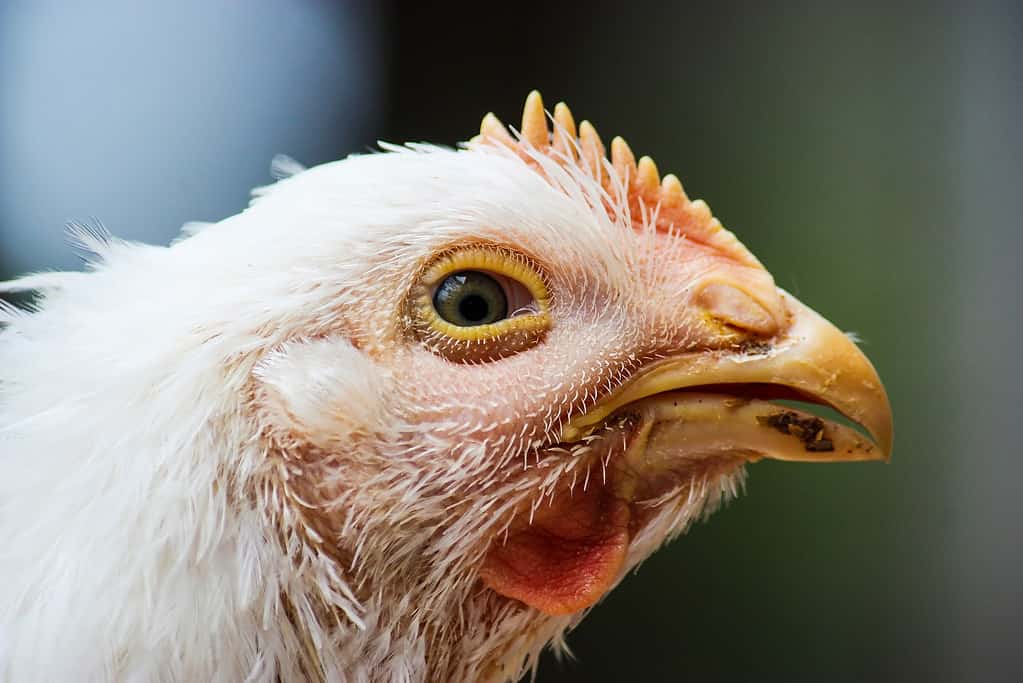Whether you are new to the world of poultry or have kept chickens for several years, you may have questions about their anatomy. Understanding what parts make up chickens (hens and roosters) will help you provide better care and troubleshoot in the event of any issues. Below, we cover chicken anatomy 101 so you can learn a little more about your birds.
What Is the Basic Anatomy of a Chicken?
The external anatomy of chickens is the same for hens and roosters. It includes combs, ears, earlobes, wattles, eyes, eye rings, wings, beaks, hackles, spurs, shanks, tails, toes, hocks, and claws. However, the nature, size, and color may vary from breed to breed. They will also have variations between hens and roosters.
Combs
While roosters and hens have combs, they are typically more pronounced in roosters. There are eight types of combs — rose, cushion, single, pea, v-shaped, buttercup, and strawberry.
Combs help the birds regulate their body temperature by offering an avenue for heat dispersal. Breeds that develop in colder climates will have smaller combs, but chickens bred in warmer climates tend to have larger combs.
This feature may also have reproductive purposes. Roosters with larger combs may be more attractive to future mates.

Both roosters and hens have combs.
©Octopus16/Shutterstock.com
Ears
Chicken ears are set inside their heads and are not an external feature. They lead to the ear canal and have earlobes just below them. The ears and ear canals have protective feathers covering them. However, the earlobes are a unique layer of skin colored white or red, depending on the breed.
Wattles
A chicken’s wattles function similarly to its combs. They help regulate body temperature, cooling the birds down in warmer weather. These flaps of skin sit on the sides of your chicken’s throat behind its beak. They are larger in roosters and indicate testosterone levels and overall nutrition.

The wattles are located under the beak on either side of the chicken’s throat. They vary in size depending on the breed and tend to develop smaller on hens.
©Stefano Argenti/ via Getty Images
Eyes
A chicken’s eyes are protected by the eye rings. They sit on the side of the head rather than in front, giving them a better view of potential predators. While all chicken species have excellent eyesight, a few species can also see in the ultraviolet color spectrum.
Wings
A chicken’s wings originally helped it fly away from predators or a dangerous situation. However, these days, flight ability varies greatly depending on the breed. Some smaller birds still can get off the ground to some degree. But the larger breeds are too big to fly and don’t get much air.
Beaks
Beaks serve a vital role for chickens. They help the birds peck during foraging and retrieve tasty morsels from tight spaces. They are made of keratin, like our nails. When chickens have room to free range, their beaks usually get trimmed naturally. However, if your chickens spend much time in confinement, you will want to trim their beaks.

Chicken beaks are made of keratin, and they help the birds forage for hidden treats.
©GlobalP/iStock via Getty Images
Hackles
Both hens and roosters have hackles, though they serve different purposes for each sex. Roosters have longer hackles that serve a secondary purpose, and hens use theirs for defensive posturing.
Spurs
In most breeds, roosters are the only ones that develop spurs. However, that does not mean hens won’t ever have them. Spurs grow on the chicken’s shanks.
Shanks
This part of the chicken’s body is the long leg area between the foot and the hock. Those birds that have spurs will grow them on the shanks.
Tails
Both hens and roosters have tails. But there are slight differences. Tails on hens are shorter and act as stabilizers, helping them fly and keep their balance. Roosters have longer, more attractive tails. They also have sickle feathers, which are long, arching, and for decorative purposes only.

Roosters have large, beautiful tails that give them a distinctive look. The arching feather is called a sickle feather.
©iStock.com/Lois_McCleary
Toes
A chicken’s toes serve a few key purposes. They help the birds dig as they forage. The configuration of three frontal toes and one rear-facing toe ensures the birds have balance as they move.
Hocks
The hocks are located between the shank and the drumstick on the upper portion of a chicken’s legs.
Claws
Chickens use their claws for utilitarian purposes. They serve as tools to take care of an itch underneath their feathers and to unearth food from the ground.
The photo featured at the top of this post is © FiledIMAGE/Shutterstock.com
Thank you for reading! Have some feedback for us? Contact the AZ Animals editorial team.






